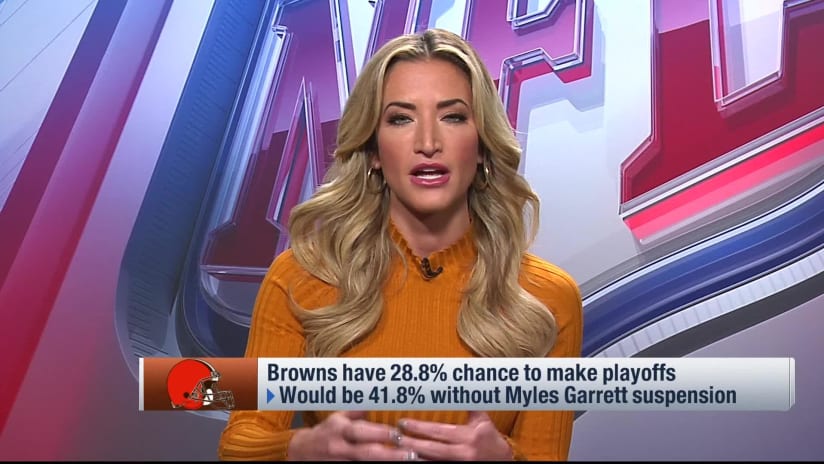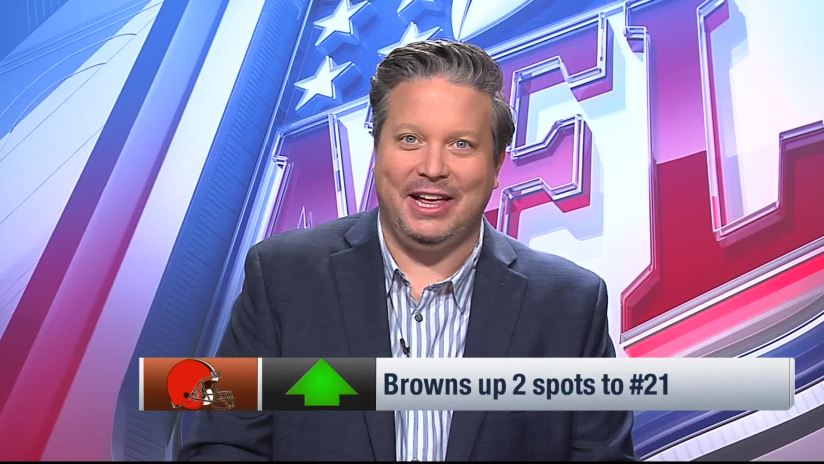NFL franchises use contextualized data to create competitive advantages. In order to realize an edge, teams need to employ the right data in the right way at the right time. This means distilling, interpreting and applying only the most influential data in a framework that accounts for their personnel, their opponents and their evolving game situations. My goal is to be your analytics department. Each week this season, I want to work for you by giving you a peek into which numbers flag in my models as the most impactful ... or the most misunderstood.
As always, let me know if your eye test is picking up on something interesting, or if there's a stat/trend you'd like me to take a deeper look at. You can hit me on Twitter @cfrelund. As with any great analytics department, the more collaborative this is, the more value we can create.
Now, let's dig into the relevant data heading into Week 12 of the 2019 NFL season:
NARRATIVE TO TRUST:
Myles Garrett's suspension seems like the death knell for the Cleveland Browns' highly disappointing season.
In the wake of last Thursday's shocking incident, Garrett is done for at least the rest of this season. The NFL's statement on the indefinite suspension presents the rationale in pretty straightforward language, citing violations "of unnecessary roughness and unsportsmanlike conduct rules, as well as fighting, removing the helmet of an opponent and using the helmet as a weapon."
So, while the Brownswon the game, they might've lost the season. Yes, Cleveland has two straight wins, improving its record to 4-6 and keeping it in the wide-open AFC wild-card race. But Garrett is the Browns' best defensive player -- and, quite possibly, best overall player. Can a team that has spectacularly underwhelmed for the bulk of the season really overcome this kind of loss and rally to make the playoffs? With this question in mind, I performed a production-based evaluation of Cleveland's postseason chances without Garrett ...
Taking Cleveland's win projections for remaining games from before Garrett's suspension and comparing them to the updated Garrett-free forecasts, I see a dramatic drop in the Browns' ability to earn a playoff berth. Ahead of last Thursday's game, my models had Cleveland earning a trip to the postseason in about 33 percent of my 700,000 simulations. Last week's matchup with the Steelers, which my model did not favor the Browns to win, was a key game that could have driven up to an 18 percent increase (depending on other AFC outcomes) in Cleveland's playoff chances. The Browns, of course, beat the rival Steelers, yet their updated playoff potential is only 28.8 percent, a drop of more than 4 percent. Here's why ...
First, my models take into account production, personnel and situations that allow for first downs and touchdowns on offense and stop first downs and touchdowns on defense. For most types of defenses against most types of offenses, the most predictive metric -- in relation to wins and losses -- is the ability to disrupt an opposing quarterback on passing downs. According to Next Gen Stats, Garrett's 49 pressures rank second in the NFL as a pure counting number, but the 17.1 percent rate they are occurring at is the highest among 207 defenders with 100-plus pass rushes (next closest is Nick Bosa at 15.7 percent). Next Gen Stats show that no single player has a higher share of his team's total pressures than Garrett's 32.2 percent. This, by the way, is more than double any of his teammates.
So, how does this relate back to wins?
Well, mapping Garrett's lost disruptions back to the Browns' ability to stop first downs and touchdowns reduces the win probabilities in each of Cleveland's remaining games between 5-8 percent. Notably, Week 15's game in Arizona swung from a win (54.2 percent of simulations) to a loss (48.2 percent). This is the kind of development that pours cold water on the narrative that Cleveland is in position to make a run, despite their remaining schedule including two contests against the winless Bengals and this week's home game against the 2-8 Dolphins. Without Garrett's immense pass-rushing production, the probabilities do not point in the Browns' favor.
NARRATIVE TO FOLLOW:
Two key matchups this week will go a long way in determining who will win a two-team competition in the NFC East between the 6-4 Dallas Cowboys and 5-5 Philadelphia Eagles.
Dallas and Philadelphia are both facing top-tier opponents on Sunday. With every remaining game mattering in this tight division race, what will each team need to do in order to emerge victorious? Here are two areas in each game that my model flagged as critical:
IF THE COWBOYS ARE TO UPSET THE PATRIOTS IN FOXBOROUGH ...
1) The defense must disrupt Tom Brady. Stop me if you've heard that before. But really, in 2019, it's even more crucial. According to Next Gen Stats, Brady has been under pressure on 23.4 percent of dropbacks this season, which is a substantial uptick from the 17.4 percent figure in 2018 (lowest in NFL). On these plays, the Patriots' 42-year-old QB has completed just 32.9 percent of his throws -- that's the second-lowest mark under pressure in the NFL this season. Brady has significantly struggled against the blitz and on quick passes, which are typically areas of strength for the six-time Super Bowl champ. Against the blitz, Brady's completion percentage has fallen to 52.4 (as opposed to 65.5 last season) and his passer rating to 76.6 (down from 108.9). On passes thrown in fewer than 2.5 seconds, Brady's 2019 completion percentage of 69.2 is 5 full percentage points lower than last season's mark of 74.2. With left tackle Isaiah Wynn returning from injured reserve, my model expects these numbers to improve. But if the Cowboys' front wins the battle in the trenches, Brady could post his fourth touchdown-free game of the season -- not to mention, he could add to the five picks he's thrown in the past seven outings.
2) Dak Prescott has to diagnose New England's defense very quickly. Dak's ability to promptly understand where in the Pats defense he can find success is very likely to determine the outcome of this game. The Cowboys' QB is playing at an elite level right now, but so is New England's defense. While Prescott just enjoyed his third game of the season with 400-plus passing yards, the Patriots' man coverage (which Bill Belichick deploys an NFL-high 61.6 percent of the time, according to Pro Football Focus) will present his greatest challenge yet. In man-to-man coverage this season, New England has snagged 12 interceptions (six more than the next-closest team, per PFF) while allowing just two touchdowns. It's also worth pointing out that Amari Cooper has the seventh-highest catch rate in the NFL against man defenses (70.3, with three touchdowns, per PFF). But it's more about how the levels of the defense work together to create leverage (or show the wrong leverage to deceive a QB). This allows the Pats to be efficient all over the field -- including outside the numbers, where they are the best in the NFL, allowing a 41.8 completion percentage and earning five interceptions, per Next Gen Stats. This is a strength-vs.-strength situation, as Dak has the best passer rating outside the numbers (116.1) and second-best completion percentage (70.1).
IF THE EAGLES ARE TO SNAP THE VISITING SEAHAWKS' THREE-GAME WINNING STREAK ...
1) The passing defense must continue to improve. Over the past three games, the front and back of Philly's defense have worked much better together, creating a 14.5 percent uptick from the first seven games of the year in QB disruptions on dropbacks (times a defender gets within 5 feet of an opposing quarterback). The Eagles have also seen a 13.9 percent improvement in drive-stopping coverage on passing attempts (defenders limiting catches and yards after the catch to reduce first-down conversions). The result of both? Philly has allowed just 14.7 points per game over the last three games (as opposed to 26.6 in the first seven). And the opposition's passer rating (75.9, down from 95.2) and completion percentage (51.5, down from 65.7) have both plummeted over this three-week period, too.
2) The offense cannot turn the ball over. Over his past four games, Carson Wentz alone has fumbled the ball five times, losing three, while also throwing a pick. The team as a whole has 10 fumbles (five lost) in this span. Over the Seahawks' past three games, they've earned seven takeaways, giving them 19 on the season (tied for fourth most). Last week, when Eagles RT Lane Johnson exited the game, Philly's ability to protect Wentz from pressure dropped significantly. According to Next Gen Stats, Wentz was sacked five times on 33 dropbacks without Johnson, as opposed to zero on 12 dropbacks with Johnson. The difference in this week's matchup is that the Seahawks' takeaways aren't really coming from disruption up front. Seattle is tied for 28th in sacks (20) and ranks 31st in QB hits (39). This means that staying efficient on early downs will be necessary for Wentz and his banged-up receivers, who rank last in total yards this season (1,008), to strategically avoid situations where turnovers are more likely.
TWO WEEK 12 SLEEPERS
Ryan Griffin, TE, New York Jets: With 12.4 yards per target in the last four weeks, Griffin leads tight ends in this category (among those with at least 10 targets). In the past four weeks, Griffin has caught 16 of 18 targets, and 11 of his 16 receptions -- including all three of his touchdowns -- came on passes with a time to throw over 2.5 seconds, per Next Gen Stats. Especially with questions along the Jets' offensive line, Griffin's ability to keep working as plays break down and act as a safety valve for Sam Darnold has created reliable production from the veteran tight end.
Russell Gage, WR, Atlanta Falcons: While tight end Austin Hooper has been out with an MCL sprain, Gage has seen his opportunities increase. His production in short-yardage situations has helped the Falcons' offense keep the chains moving, which is especially helpful with Atlanta's injuries at the running back position. Over the past three games, Gage has played 55 percent of snaps (per NGS) and 12 of his 13 receptions have come within 10 yards of the line of scrimmage.
Follow Cynthia Frelund on Twitter @cfrelund.


